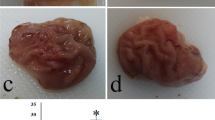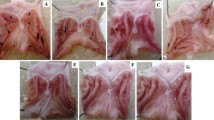Abstract
The mucus layer that covers gastric mucosa is a powerful barrier that protects tissues from the hazardous gastric environment; however, the role of each gastric MUC type, such as MUC1, MUC5AC, and MUC6, has not been evaluated. The purpose of this study is to identify the MUC type, which plays a predominant role in this protective process by use of geranylgeranylacetone (GGA), a promising cytoprotective agent. In addition, the mechanism of mucus secretion promoted by GGA was investigated. Rat gastric mucosal damage was provoked using ethanol, and GGA was pretreated 1 hour before ethanol. GGA was found to significantly protect rats from ethanol-induced gastric damage by increasing mucus levels, MUC5AC and MUC6, especially at ethanol-induced ulcer margins, but not by MUC1. When expression of heat shock protein 70 (HSP70) and neuronal nitric oxide synthase (nNOS) was evaluated by Western blotting, both were found to be increased in GGA-treated ethanol rats. In addition, the cytoprotective effect of GGA was blocked by l-NMMA, a nonspecific NOS inhibitor, but not blocked by aminoguanidine, a specific inducible nitric oxide synthase inhibitor, thus indicating the participation of nNOS. In conclusion, GGA protected ethanol-induced gastric damage by upregulating MUC5AC and MUC6 rather than MUC1. In addition, HSP70 and nNOS were found to be involved in GGA cytoprotection, probably by increasing mucus production or secretion.
Similar content being viewed by others
References
Flemstrom G, Garner A: Gastroduodenal HCO3(-) transport: Characteristics and proposed role in acidity regulation and mucosal protection. Am J Physiol Gastrointest Liver Physiol 242:G183–G193, 1982
Allen A, Flemstrom G, Garner A, Kivilaakso E: Gastroduodenal mucosal protection. Physiol Rev 73:823–857, 1993
Feil W, Klimesch S, Karner P, et al.: Importance of an alkaline microenvironment for rapid restitution of the rabbit duodenal mucosa in vitro. Gastroenterology 97:112–122, 1989
Barnard J, Beauchamp R, Russell W, Dubois R, Coffey R: Epidermal growth factor-related peptides and their relevance to gastrointestinal pathophysiology. Gastroenterology 108:564–580, 1995
Corfield AP, Carroll D, Myerscough N, Probert CS: Mucins in the gastrointestinal tract in health and disease. Front Biosci 1:1321–1357, 2001
Arias EB, Verhage HG, Jaffe RC: Complementary deoxyribonucleic acid cloning and molecular characterization of an estrogen-dependent human oviductal glycoprotein. Biol Reprod 51:685–694, 1994
Williams SJ, McGuckin MA, Gotley DC, Eyre HJ, Sutherland GR, Antalis TM: Two novel mucin genes down-regulated in colorectal cancer identified by differential display. Cancer Res 59:4083–4089, 1999
Byrd JC, Bresalier RS: Mucins and mucin binding proteins in colorectal cancer. Cancer Metastasis Rev 23:77–99, 2004
Corfield AP, Myerscough N, Longman R, Sylvester P, Arul S, Pignatelli M: Mucins and mucosal protection in the gastrointestinal tract: new prospects for mucins in the pathology of gastrointestinal disease. Gut 47:589–594, 2000
Ho SB, Shekels LL, Toribara NW, et al.: Mucin gene expression in normal, preneoplastic, and neoplastic human gastric epithelium. Cancer Res 55:2681–2690, 1995
Ho SB, Niehans GA, Lyftogt C, et al.: Heterogeneity of mucin gene expression in normal and neoplastic tissues, Cancer Res 53:641–651, 1993
Lee HS, Lee HK, Kim HS, Yang HK, Kim YI, Kim WH: MUC1, MUC2, MUC5AC, and MUC6 expressions in gastric carcinomas. Cancer 92:1427–1434, 2001
Reis CA, David L, Seixas M, Burchell J, Sobrinho-Simoes M: Expression of fully and under-glycosylated forms of MUC1 mucin in gastric carcinoma. Int J Cancer 79:402–410, 1998
Reis CA, David L, Nielsen PA, et al.: Immunohistochemical study of MUC5AC expression in human gastric carcinomas using a novel monoclonal antibody. Int J Cancer 74:112–121, 1997
Ho SB, Roberton AM, Shekels LL, Lyftgof CT, Niehans GA, Toribara NW: Expression cloning of gastric mucin complementary DNA and localization of mucin gene expression. Gastroenterology 109:735–747, 1995
Carrato C, Balague C, Bolos C, et al.: Differential apomucin expression in normal and neoplastic human gastrointestinal tissues. Gastroenterology 107:160–172, 1994
Filipe MI, Linehan JM, Durrant LG, et al.: Expression of a peptide epitope of the colonic mucin MUC2 in precursor lesions of gastric carcinoma. Eur J Cancer Prev 5:287–295, 1996
Jass JR, Walsh MD: Altered mucin expression in the gastrointestinal tract: A review. J Cell Mol Med 5:327–351, 2001
Murakami M, Oketani K, Fujisaki H, Wakabayashi T, Ohgo T: Effects on the antiulcer drug geranylgeranylacetone on aspirin induced gastric ulcers in rats. Jpn J Pharmacol 32:299–306, 1982
Arakawa T, Yamada H, Nakamura A, et al.: Gastric cytoprotection by tetraprenylacetone in human subjects. Digestion 39:111–117, 1988
Terano A, Hiraishi H, Ota S, Sugimoto T: Geranylgeranylacetone, a novel antiulcer drug, stimulates mucus synthesis and secretion in rat gastric culture cells. Digestion 33:206–210, 1986
Hirakawa T, Rokutan K, Nikawa T, Kishi K: Geranylgeranylacetone induces heat shock proteins in cultured guinea pig gastric mucosal cells and rat gastric mucosa. Gastroenterology 111:345–357, 1996
Bilski J, Sarosik J, Murty VL, et al.: Enhancement of the lipid content and physical properties of gastric mucus by geranylgeranylacetone. Biochem Pharmacol 36:4059–4065, 1987
Fujimoto M, Yamanaka T, Bessho M, Igarashi T: Effects of geranylgeranylacetone on gastrointestinal secretion in rats. Eur J Pharmacol 77:113–118, 1982
Terano A, Shiga J, Hiraish H, Ota S, Sugimoto T: Protective action of tetraprenylacetone against ethanol-induced damage in rat gastric mucosa. Digestion 35:182–188, 1986
Pandit S, Sur TK, Jana U, Bhattacharyya D, Debnath PK: Anti-ulcer effect of shankha bhasma in rats: A preliminary study. Indian J Pharm 32:378–380, 2000
Lacy ER, Ito S: Microscopic analysis of ethanol damage to rat gastric mucosa after treatment with prostaglandin. Gastroenterology 83:538–548, 1982
Nishida K, Ohta Y, Ishiguro I: Teprenone, an anti-ulcer agent, increase gastric mucosal mucus level via nitric oxide in rats. Jpn J Pharmacol 78:519–522, 1998
Neuhaus OW, Letzring M: Determination of hexosamine in conjunction with electrophoresis on starch. Anal Chem 29:1230–1233, 1957
Kitagawa H, Takeda F, Kohei H: A simple method for estimation of gastric mucus and effects of antiulcerogenic agents on the decrease in mucus during water-immersion stress in rats. Arzneim Forcsh/Drug Res 36:1240–1244, 1986
Nakamura K, Takahashi T, Taniuchi M, Hsu CX, Owyang C: Nicotinic receptor mediates nitric oxide synthase expression in the rat gastric myenteric plexus. J Clin Invest 101:1479–1489, 1998
Matsumoto T, Mitchell JA, Schmidt HH, et al.: Nitric oxide synthase in ferret brain: localization and characterization. Br J Pharmacol 107:849–852, 1992
Murakami M, Oketani K, Fujisaki H, Wakabayashi T: Effect of geranylgeranylacetone (GGA) on gastric lesions induced by topical aspirin plus HCl. Jpn J Pharmacol 32:921–924, 1982
Kawakubo M, Ito Y, Okimura Y, et al.: Natural antibiotic function of a human gastric mucin against Helicobacter pylori infection. Science 305:1003–1006, 2004
Dekker J, Rossen JWA, Buller HA, Einerhand AWC: The MUC family: An obituary. Trends Biochem Sci 27:126–131, 2002
Wataru T, Naoko T, Chiho K, Kazuhito R, Tomofusa T, Tohru M: Expression of immediate early genes, HSP70, and COX-2 mRNAs in rat stomach following ethanol ingestion. Dig Dis Sci 45:2455–2462, 2000
Desseyn JL, Buisine MP, Porchet N, Aubert N, Degand P, Laine A: Evolutionary history of the 11p15 human mucin gene family. J Mol Evol 46:102–106, 1998
Byrd JC, P Sternberg YL, Yunker CK, Scheiman JM, Bresalier RS: Aberrant expression of gland-type gastric mucin in the surface epithelium of Helicobacter pylori-infected patients. Gastroenterology 113:455–464, 1997
Robert A: Cytoprotection by prostaglandins. Gastroenterology 77:761–767, 1979
Robert A, Nezamis JE, Lancaster C, Hanchar AJ: Cytoprotection by prostaglandins in rats: Prevention of gastric necrosis produced by alcohol, HCl, NaOH, hypertonic NaCl and thermal injury. Gastroenterology 77:433–443, 1979
Tsukimi Y, Okabe S: Recent advances in gastrointestinal pathophysiology: Role of heat shock proteins in mucosal defense and ulcer healing. Biol Pharm Bull 24:1–9, 2001
Rokutan K, Teshima S, Kawai T, et al.: geranylgeranylacetone stimulates mucin synthesis in cultured guinea pig gastric pit cells by inducing a neuronal nitric oxide synthase. J Gastroenterol 35:673–681, 2000
Nishida K, Ohta Y, Ishiguro I: Preventive effect of teprenone on stress-induced gastric mucosal lesions and relation to gastric mucosal constitutive nitric oxide synthase activity. Pharmacol Res 39:325–332, 1999
Hiraishi H, Terano A, Ota S, et al.: Role for mucous cells against toxic oxygen metabolites. J Lab Clin Med 121:570–578, 1993
Wataru T, Naoko T, Chiho K, Kazuhito R, Tomofusa T, Tohru M: Geranylgeranylacetone protects cultured guinea pig gastric mucosal cells from indomethacin. Dig Dis Sci 45:1674–1679, 2000
Tatsunori T, Shinji T, Wataru T, Tatsuya H, Tomofusa T, Tohru M: Geranylgeranylacetone protects guinea pig gastric mucosal cells from gastric stressor-induced apoptosis. Dig Dis Sci 47:1546–1553, 2002
Hirakawa T, Rokutan K, Nikawa T, Kishi K: Geranylgeranylacetone induces heat shock proteins in cultured guinea pig gastric mucosal cells and rat gastric mucosa. Gastroenterology 111:345–357, 1996
Mizuno H, Sakamoto C, Matsuda K, et al.: Induction of cyclooxygenase 2 in gastric mucosal lesions and its inhibition by the specific antagonist delays healing in mice. Gastroenterology 112:387–397, 1997
Shigeta J, Takahashi S, Okabe S: Role of cyclooxygenase-2 in the healing of gastric ulcers in rats. J Pharmacol Exp Ther 286:1383–1390, 1998
Lopes-Belmonte JB, Whittle GSJ, Moncada S: The actions of nitric oxide donors in prevention or induction of injury to the rat gastric mucosa. Br J Pharmacol 108:73–78, 1994
Takeuchi K, Ohuchi T, Okabe S: Endogenous nitric oxide in gastric alkaline response in the rat stomach after damage. Gastroenterology 106:367–374, 1994
Masuda E, Kawano S, Nagano K, et al.: Endogenous nitric oxide modulates ethanol-induced gastric mucosal injury in rats. Gastroenterology 108:58–64, 1995
Ohta M, Tanoue K, Tarnawski AS, et al.: Overexpressed nitric oxide synthase in portal-hypertensive stomach of rat: key role to increased susceptibility to damage? Gastroenterology 112:1920–1930, 1997
Mercer DW, Castaneda AA, Denning JW, Chang L, Russel DH: Effects of endotoxin on gastric injury from luminal irritants in rats: potential roles of nitric oxide. Am J Physiol 275:G449–G459, 1998
Author information
Authors and Affiliations
Corresponding author
Rights and permissions
About this article
Cite this article
Nam, S.Y., Kim, N., Lee, C.S. et al. Gastric Mucosal Protection via Enhancement of MUC5AC and MUC6 by Geranylgeranylacetone. Dig Dis Sci 50, 2110–2120 (2005). https://doi.org/10.1007/s10620-005-3016-8
Received:
Accepted:
Issue Date:
DOI: https://doi.org/10.1007/s10620-005-3016-8




